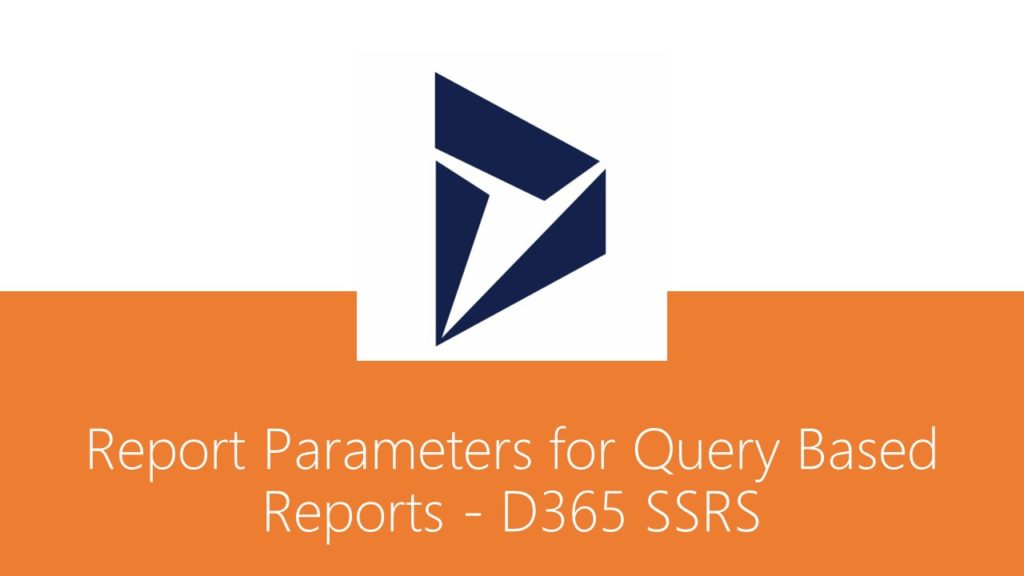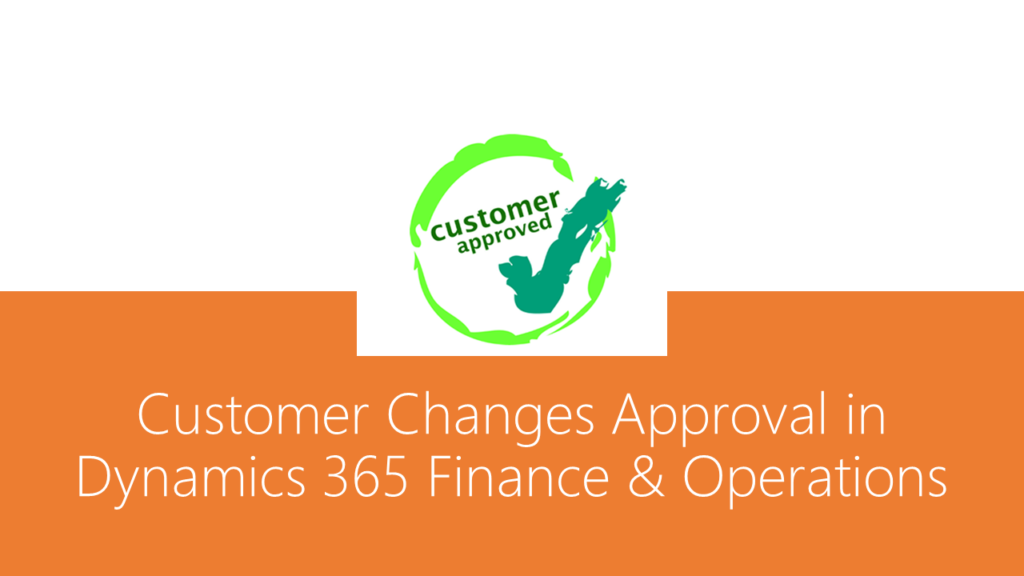Dynamics 365, New Dynamics AX
D365 F&O Financial Dimensions – Cool Features
Overriding Dimension values after posting the transactions
There might be a situation where in the dimension value may need to be corrected or updated in the dimension values master even after posting transactions.
For example, let’s take the legal entity backed “Business unit” financial dimension with dimension value “004” and the same is attached with some master record or might have attached and posted some transactions. Later it has been realized that the dimension value should be corrected as “400” from “004”.
To accomplish this, navigate to the business unit master, through Organisation administration > Organisation > Operating units, and select the dimension value “004” and edit the value to “400” from “004”. System will pop up the below shown message and will update the dimension value in all the masters as well as transactions.
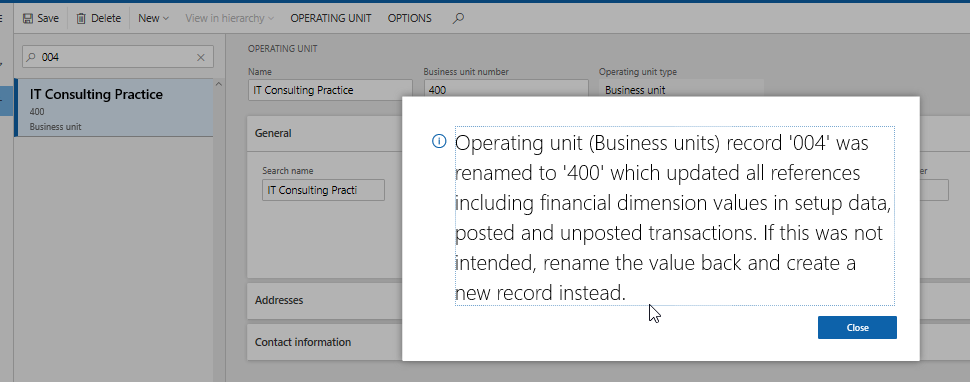
Copy dimension values upon creating the master record
This feature will be used for legal entity backed dimensions. For example, when “Project” is set as one of the financial dimensions and if this feature is turned on, system will set the project dimension automatically on the project master record up on creating a new project record.
To enable this feature, navigate to the financial dimensions form and create a new legal entity backed dimension as “Projects” and mark the “Copy values to this dimension on each new project created” check box as shown in the below screenshot.
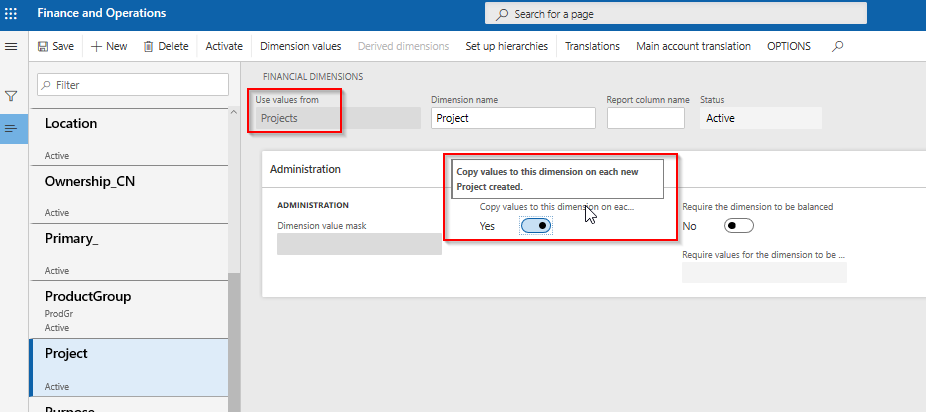
Now try creating a new project in “Project management and accounting” module. Notice that once the project gets created, system will default the project dimension with the same newly created project id on the same record as shown in the below screenshots.
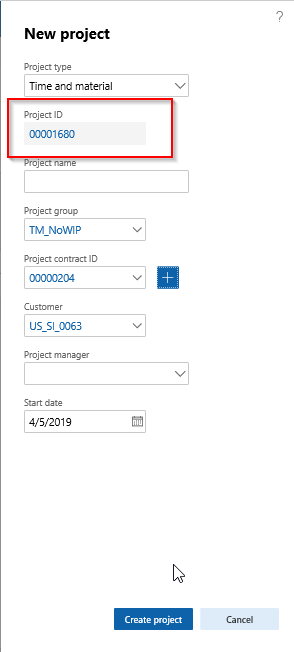
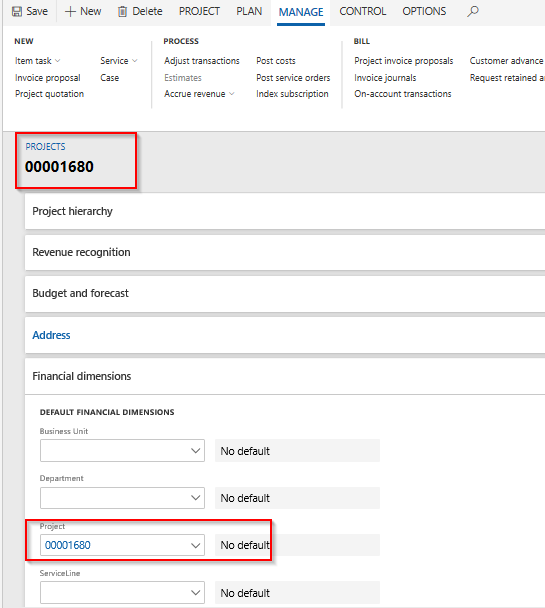
More about Financial Dimensions:
Dynamics 365, New Dynamics AX
D365 F&O Financial Dimensions – Derived Dimensions
This feature is used to derive and default the dimension values automatically based on the current dimension value selection while posting transactions or creating master records.
For example, when the “Business Unit” dimension value “003” is selected while creating either master records or transactions, system will automatically default the “Department” dimension value to “023” as per the derived dimension configuration as shown below.
To accomplish this, navigate to the financial dimensions form and select the “Business Unit” dimension, and click on “Derived dimension” button.
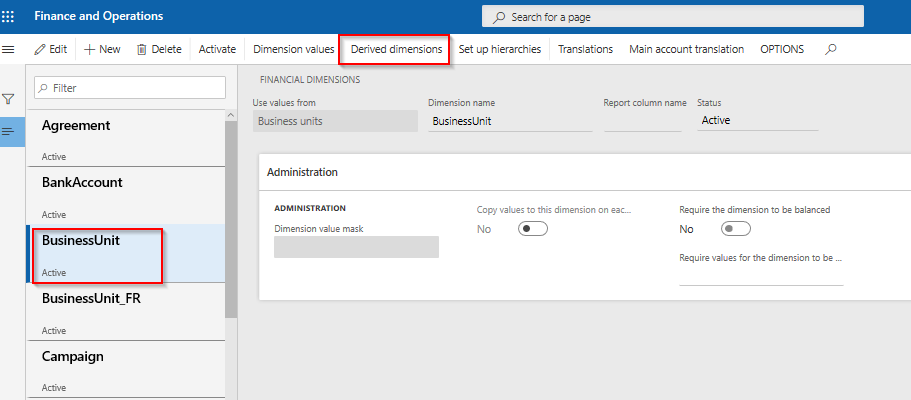
Click on “Add segment” button to add the required dimension that needs to be defaulted upon the selecting the “Business Unit” dimension value that was set.
Select the “Department” dimension and click on “Add segment” button. System will add the “Department” dimension besides the “Business Unit” field in the grid. More dimension segments can be added following the same set of steps.
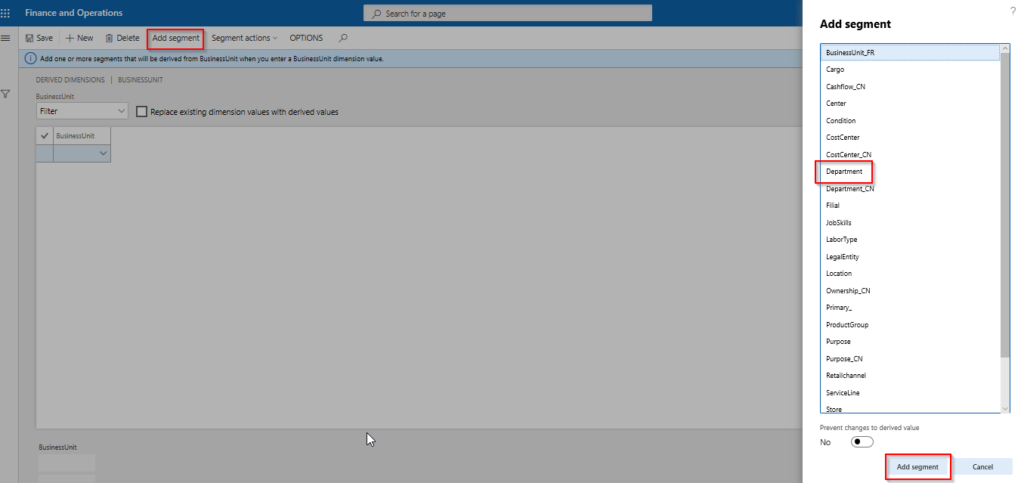
In the “Business Unit” segment, select the dimension value “003” and in the “Department” segment, select the dimension value “023”.
Now try creating a new vendor and attach the financial dimensions by selecting the “Business Unit” dimension value “003”. Notice that system will automatically set “Department” dimension value to “023” on the vendor record as shown in the below screenshot. Later the “Department” dimension value can be edited manually.
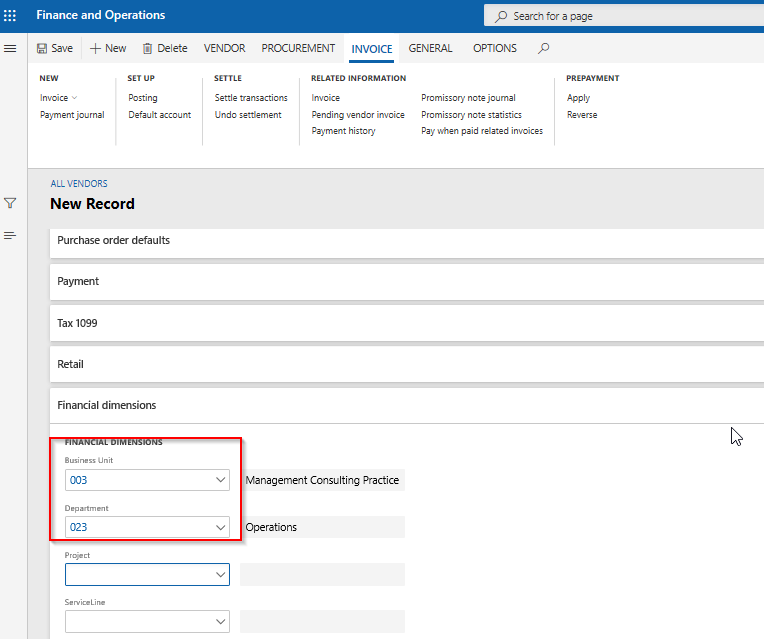
Prevent changes to derived value
There is a check box option as “Prevent changes to derived value” available while adding a new segment in the derived dimension form. This option will lock down the derived dimensions from user selection by making them non-editable on both master and transaction forms.
As per the above example, “Department” dimension value will be derived and gets defaulted to “023” upon selecting the “Business Unit” dimension value as “003”. At the same time “Department” dimension field gets greyed out as shown in the below screenshot on the vendor record.
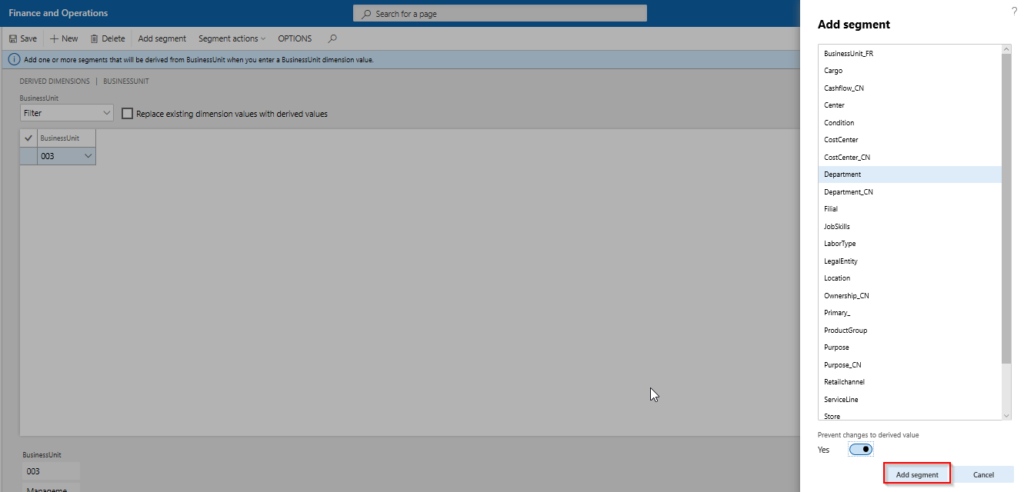
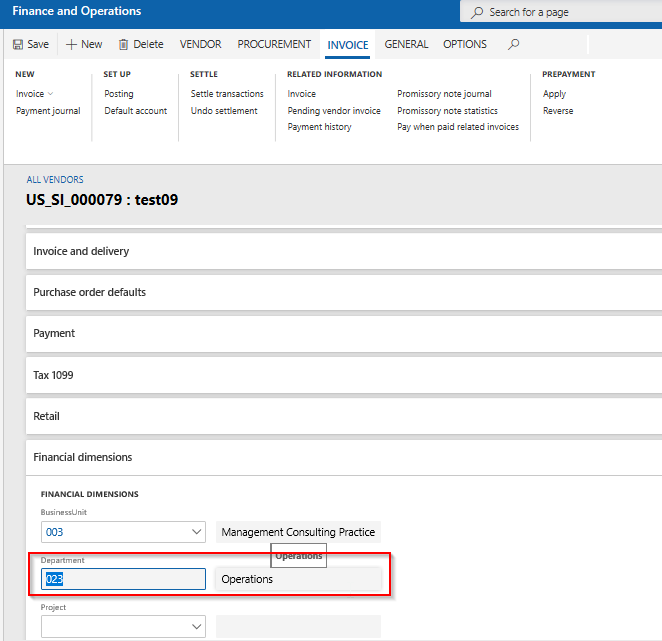
Note that, this option can always be reverted even after enabling it while adding the segment. To accomplish this, navigate to the “Derived dimension” form and focus on “Department (prevent changes)” and click on “Segment actions” button and next click on “Allow Department value changes” button as shown in the below screenshot.
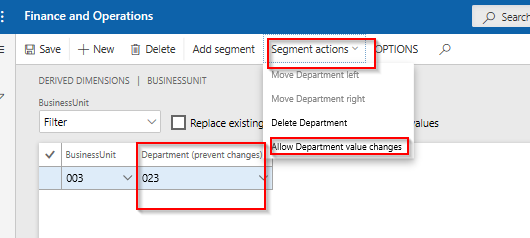
Replace existing dimension values with derived values
With this feature, the option of replacing the derived dimension values can be controlled based on the selection of main dimension values, in both master and transaction records.
There is a check box option as “Replace existing dimension values with derived values” available on the “Derived dimensions” form.
If this check box is marked, system will automatically replace the derived dimension values upon the changing the main dimension value.
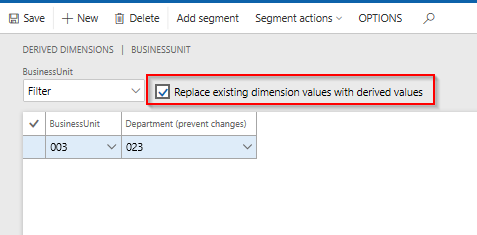
Let’s go back to our example and set the “Business Unit” dimension value as “004” and “Department” dimension value as “024” manually on the vendor record. Later change the “Business Unit” dimension value as “003”.
If the check box is marked, system will default the “Department” dimension value as “023” on the vendor record. If the check box is not marked, system will not default the “Department” dimension value as “023” and leaves it as “024” on the vendor record.
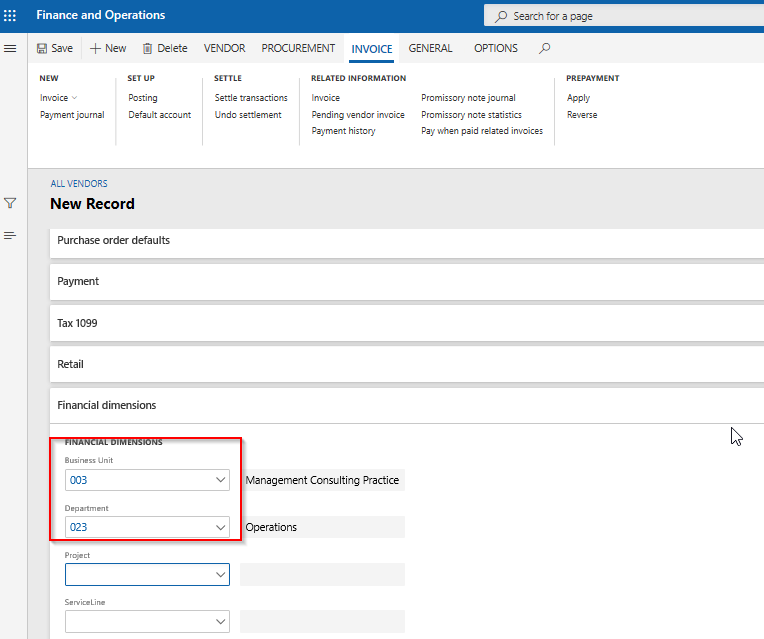
More about Financial Dimensions:
Dynamics 365, New Dynamics AX
D365 F&O Financial Dimensions – Introduction
This topic is going to give you a high-level illustration on few key features of Financial Dimensions in D365 Finance & Operations, which could be very useful for day to day data entry and control.
Financial dimension in D365 Finance & Operations is the key feature that is used to slice and dice the financial transactions for better reporting and decision making. D365 Finance & Operations has support to setup multiple financial dimensions in one legal entity. Financial dimensions can be categorized into 2 types as listed below
- Custom dimensions – Custom dimensions are shared across legal entities. Custom dimension values will be setup and maintained manually.
- Legal entity backed dimensions – Legal entity backed dimensions are mostly legal entity specific. This dimension type enables any existing master (Ex- Customer, Vendor etc.) of that legal entity, as a financial dimension by auto populating each master table record values as financial dimension values. But there are few out of box legal entity backed dimensions like Business unit, Cost centre etc. which are shared across legal entities.
It is very important to understand the company structure and reporting requirements before setting up these different financial dimensions that can be applicable to each legal entity.
In D365 Finance & Operations, Financial dimensions can be seen under General ledger > Chart of accounts > Dimensions > Financial dimensions.

Legal entity overrides
Though the financial dimension values are shared across legal entities, there can be a requirement where in some of the financial dimension values might be applicable to only few specific legal entities but not all, for ever or for certain period.
For example, the Business unit dimension value named “Management Consulting Practise (003)”, is not applicable for the legal entity FRRT as per business requirement. This can be accomplished by navigating to the financial dimensions form and select the “Business unit” financial dimension and click on “Dimension values” button as shown in the below screenshot.

Select the “Management Consulting Practise (003)” dimension value and click “Add” button under “Legal entity overrides” tab.

From the drop down select the FRRT legal entity and marked the “Suspended” check box and set the “Active from” and “Active to” as required to suspend the selected dimension values for the selected legal entity for the given period.

Translations
As per standard, while creating a new financial dimension, system will not allow spaces while setting up the dimension name. For example, the standard dimension Business unit, system will accept the dimension name as “BusinessUnit” without any space, and the same name will be displayed everywhere on master and transaction forms.

Now to display or change the name to “Business unit” from “BusinessUnit”, navigate to the financial dimensions form and select the “BusinessUnit” financial dimension and click on “Translations” button as shown in the below screenshot.
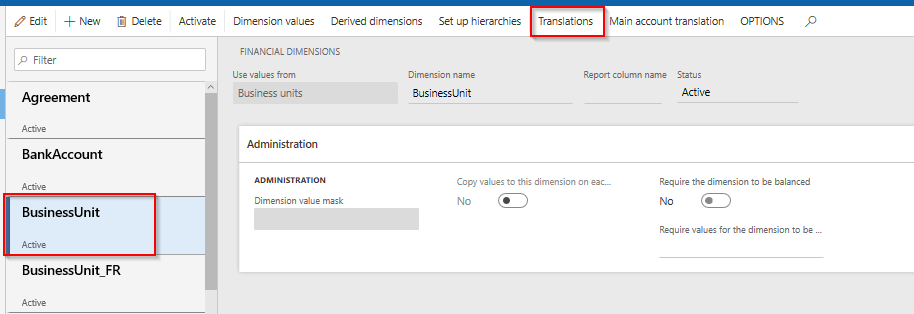
In the “Translated text” field, set the dimension name as appropriate which in this case should be “Business Unit”.
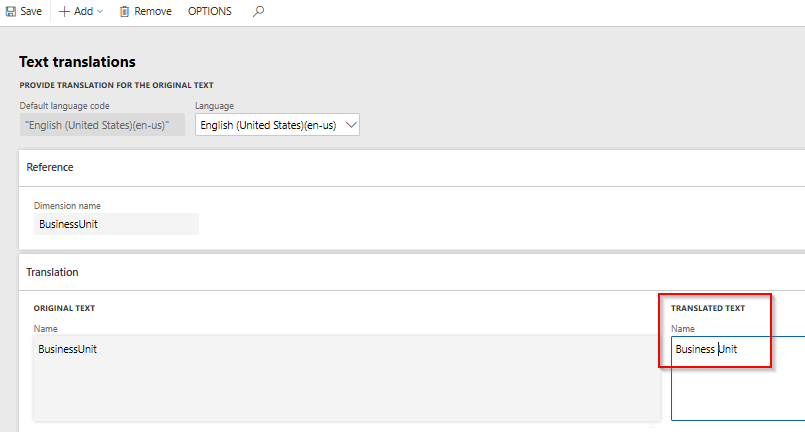
Now the same name can be seen in all the master and transaction forms as shown in the below screenshot. The name can be set in any language by selecting the appropriate language as well.
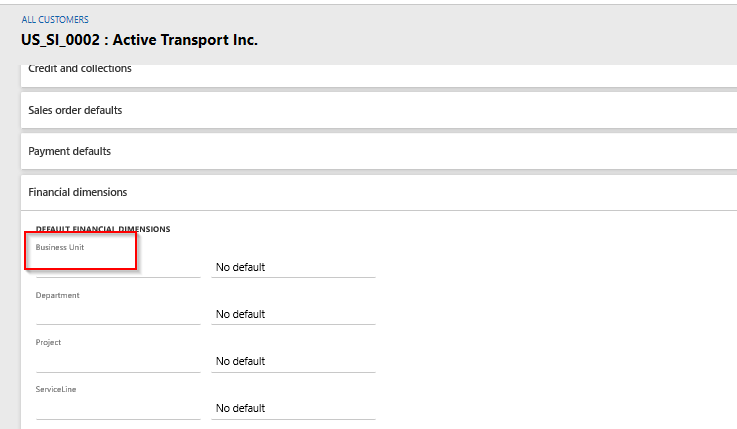
More about Financial Dimensions:
AX 2012, Dynamics 365, SSRS Reporting, X++
Report Parameters for Query Based Reports – D365 SSRS
There have been many instances in projects where query-based reports are created and later customer has requested adding few filters directly on report dialog instead of adding as a range on query. At this point, converting the entire report to RDP-based is not a good option.
This post explains how one can add filters / parameters directly to Report RDL and handle validations / UI changes through AX.
Take a simple example of creating a customer transaction report that is query based.
Pre-requisite development
This article does not cover creation of few artefacts. It is expected that readers are aware of those steps and can create following artefacts before moving further:
- Create a new query for report with CustTrans table as data source
- Create a new report with the query created above and create a simple design
- Create a controller class that executes this report
- Create an output menu item that invokes the controller class to execute the report
Once above artefacts are created, go ahead to add two parameters “From date” and “To date” that applies to TransDate on CustTrans and will be added as range to query. Note that these parameters are not required as a range field in “Records to include” section but rather directly on the report dialog. In order to do this, make following code changes.
Create New Parameters Directly On The Report
Open the required custom report and expand Parameters section, right click on Parameters section and select New > Parameter

Set following properties for the parameter:
- Name: FromDate
- Data Type: DateTime
- Prompt String: From date
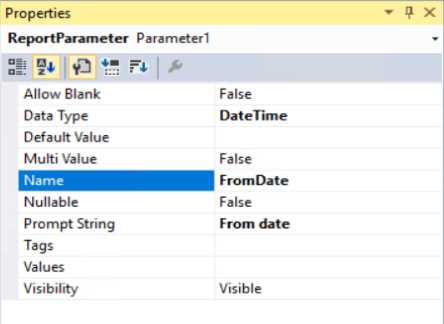
Repeat above steps for ToDate parameter. Changes required for report design are complete.
Create New Contract Class
Next step is to create new contract class extending from SrsReportRdlDataContract class. This class is required to add a validation that From date value is always less than or equal to To date value.
Note: Data contract classes used for Report Data Provider based reports utilizes DataContract and DataMember attributes to define report parameters. This data contract class needs no such attributes. This class is only required if reader wishes to perform some validations.
Following is a sample code that can be written for performing validations:
/// <summary>
/// The <c>AXPCustTransRDLReportRDLContract</c> class is the contract class for the <c>AXPCustTransRDLReport</c> report.
/// </summary>
[
SrsReportNameAttribute('AXPCustTransRDLReport.Report'),
SysOperationContractProcessingAttribute(classStr(AXPCustTransRDLReportUIBuilder),
SysOperationDataContractProcessingMode::CreateUIBuilderForRootContractOnly)
]
class AXPCustTransRDLReportRDLContract extends SrsReportRdlDataContract
{
#define.parameterFromDate('FromDate')
#define.parameterToDate('ToDate')
/// <summary>
/// Validates the parameters.
/// </summary>
/// <returns>
/// true if successful; otherwise, false.
/// </returns>
public boolean validate()
{
boolean ret = super();
if (this.getValue(#parameterFromDate) && this.getValue(#parameterToDate))
{
// Check that the FromDate is greater than ToDate
if (this.getValue(#parameterFromDate) > this.getValue(#parameterToDate))
{
ret = checkFailed("@SYS16982");
}
}
return ret;
}
}Create New UI Builder Class
The next step in this exercise is to create a UI builder class that can set some of the properties for these date dialog controls. This is required as SSRS has DataTime data type. This causes the filter controls to be rendered with Date and time options. This illustration needs only date option to be displayed.
In order to achieve this, create a UI builder class and set some of the properties of the dialog controls to display the filters in correct date format.
The class extends from regular SrsReportDataContractUIBuilder class. A sample code is illustrated below:
/// <summary>
/// The <c>AXPCustTransRDLReportUIBuilder</c> class is the UIBuilder class for the <c>AXPCustTransRDLReport</c> report.
/// </summary>
[
SrsReportNameAttribute('AXPCustTransRDLReport.Report'),
SysOperationContractProcessingAttribute(classstr(AXPCustTransRDLReportUIBuilder), SysOperationDataContractProcessingMode::CreateUIBuilderForRootContractOnly)
]
class AXPCustTransRDLReportUIBuilder extends SrsReportDataContractUIBuilder
{
#define.parameterFromDate('FromDate')
#define.parameterToDate('ToDate')
DialogField dialogFromDate;
DialogField dialogToDate;
AXPCustTransRDLReportRDLContract contract;
/// <summary>
/// Builds the dialog for the <c>AXPCustTransRDLReport</c> SSRS report.
/// </summary>
public void build()
{
Dialog dialogLocal;
dialogLocal = this.dialog();
contract = this.getRdlContractInfo().dataContractObject() as AXPCustTransRDLReportRDLContract;
dialogLocal.addGroup();
dialogFromDate = dialogLocal.addFieldValue(extendedTypeStr(FromDate),DatetimeUtil::date(contract.getValue(#parameterFromDate)), "@SYS5209","");
dialogToDate = dialogLocal.addFieldValue(extendedTypeStr(ToDate),DatetimeUtil::date(contract.getValue(#parameterToDate)), "@SYS14656");
}
/// <summary>
/// Transfers data from the dialog into the data contract object.
/// </summary>
public void getFromDialog()
{
contract.setValue(#parameterFromDate, DateTimeUtil::newDateTime(dialogFromDate.value(), 0));
contract.setValue(#parameterToDate, DateTimeUtil::newDateTime(dialogToDate.value(), 0));
}
}
Controller Class Changes
Once report parameter changes are done, go ahead with reading these parameters and apply ranges on the report query before it is executed. In order to apply ranges, modify the report controller class to add these filters before executing the report query. This is done by overriding the preRunModifyContract method of controller class and adding the code as shown below:
/// <summary>
/// The <c>AXPCustTransRDLReportController</c> class starts the customer trans - demo report.
/// </summary>
class AXPCustTransRDLReportController extends SrsReportRunController
{
#define.ReportName ('AXPCustTransRDLReport.Report')
#define.parameterFromDate('FromDate')
#define.parameterToDate('ToDate')
/// <summary>
/// Override this method to change the report contract before running the report.
/// </summary>
protected void preRunModifyContract()
{
AXPCustTransRDLReportRDLContract contract = this.parmReportContract().parmRdlContract() as AXPCustTransRDLReportRDLContract;
Query query = this.parmReportContract().parmQueryContracts().lookup(this.getFirstQueryContractKey());
FromDate fromDate = contract.getValue(#parameterFromDate);
ToDate toDate = contract.getValue(#parameterToDate);
SysQuery::findOrCreateRange(query.dataSourceTable(tableNum(CustTrans)), fieldNum(CustTrans, TransDate)).value(queryRange(fromDate, toDate));
super();
}
public static void main(Args _args)
{
AXPCustTransRDLReportController controller = new AXPCustTransRDLReportController();
controller.parmReportName(#ReportName);
controller.parmArgs(_args);
controller.startOperation();
}
}Once all the code changes are done, build the project, deploy report and execute the report from front end. The report dialog now shows as illustrated below:
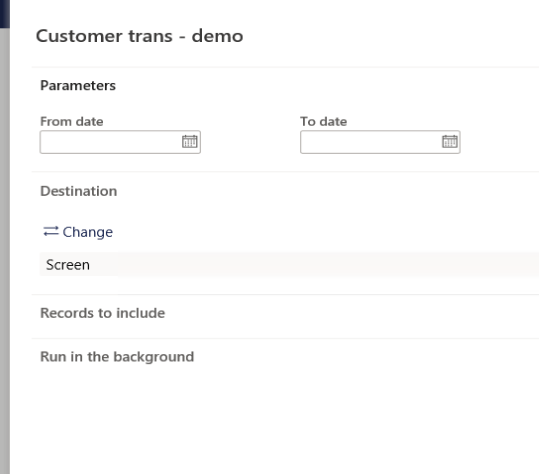
The report filters are also applied as illustrated below.
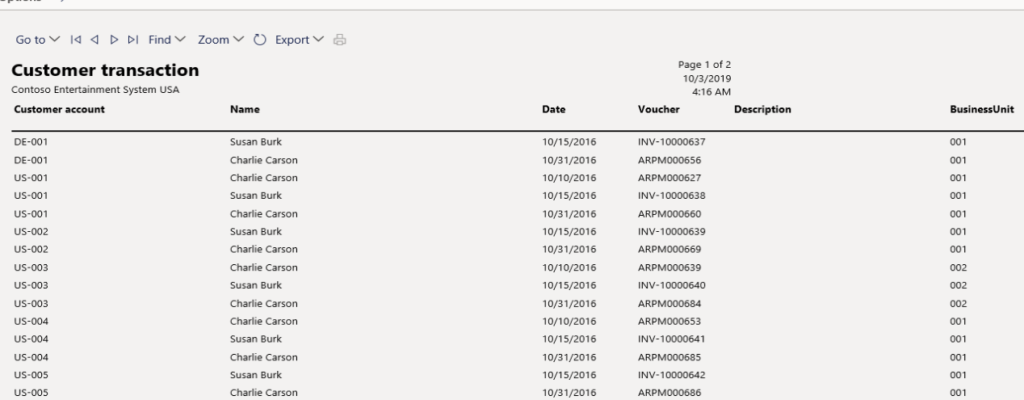
As explained in this article, one can easily add some basic filter options to query-based reports.
Happy Reporting!
Dynamics 365
Customer Change Approvals in Dynamics 365 Finance and Operations
Sometimes organisations may need approval process upon changes to the existing customer master data such as Name, Bank account etc. D365 F&O has introduced a new workflow approval feature named as Proposed customer change workflow to accomplish this requirement.
Using this feature, one can configure the approval mechanism to have a better control on updates to the specific business critical customer master data fields. This feature enables the change request to be approved before the changes get committed to the customer master record.
Parameters Setup
Below are the parameters that are required to enable this feature. Mark the Enable customer approvals check box under Accounts receivable > Setup > Accounts receivable parameters > General (Tab) > Customer approval (Tab), as shown below.
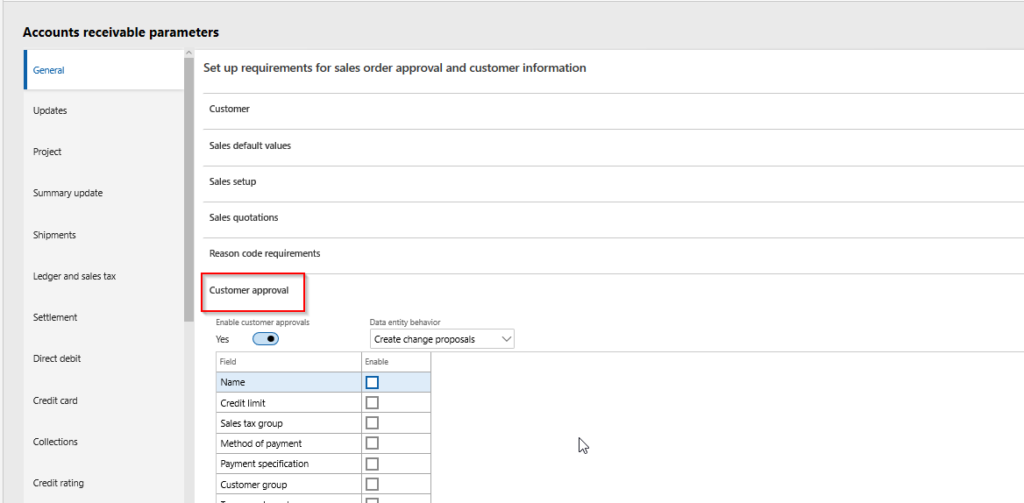
Set the Data entity behaviour value under Accounts receivable > Setup > Account receivable parameters > General (Tab) > Customer approval (Tab), from one of the 3 available lookup options, as appropriate, to control the data import behaviour through data entities.
- Allow changes without approval – Customer record can be updated without approval.
- Reject changes – Changes cannot be made to customer record.
- Create change proposals – Changes to the fields will be treated as proposed changes and subject to required approvals.

Enable the business critical fields by marking the Enable check box against each field that needs approval, under Accounts receivable > Setup > Account receivable parameters > General (Tab) > Customer approval (Tab), as shown below. In this example, Customer Name field is enabled to illustrate the process.

Workflow Configuration
Configure a new workflow by selecting the wotkflow type named Proposed customer change workflow under Accounts receivable > Setup > Accounts receivable workflows, as shown below and setup the workflow as per business need.

Update Customer Data
Once the workflow is configured, try updating the name of the existing customer from Accounts receivable > Customers > All customers > Edit.
Notice that in the customer record, Name field label will be suffixed with (Requires approval) text indicating that this field requires approval when updated.
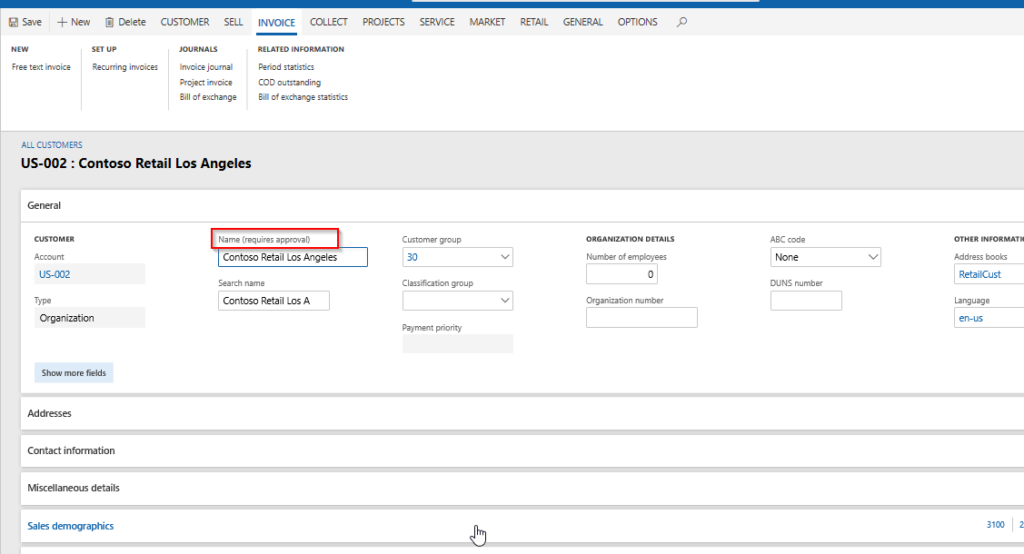
Change the customer name and observe that system will pop up a dialog by showing the current and proposed customer name, for your review and one can discard the change if required.
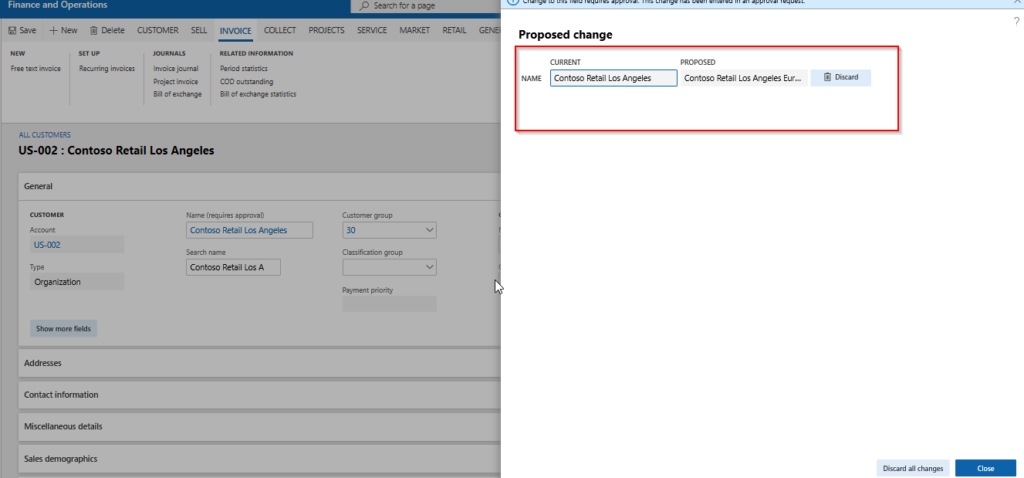
Close the Proposed change dialog and submit the change to workflow.
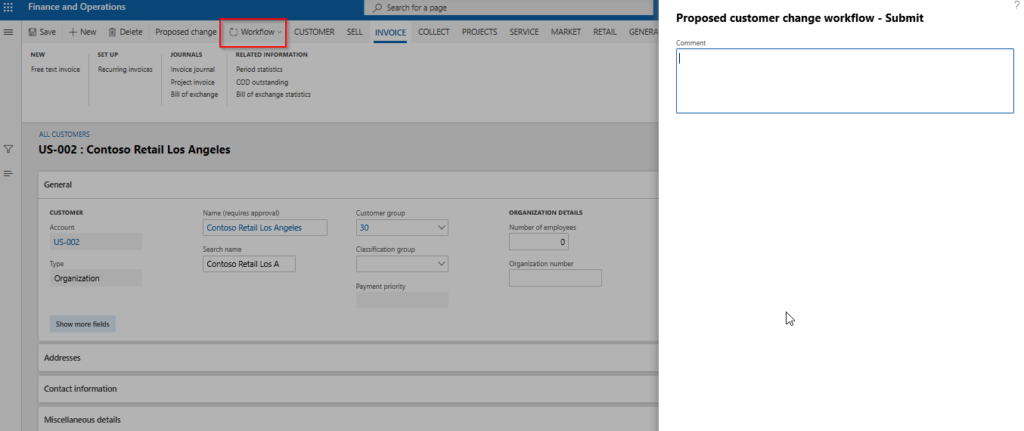
Approver can click on the Proposed change button on the customer master record, to view the proposed changes in the customer data before taking an appropriate action.
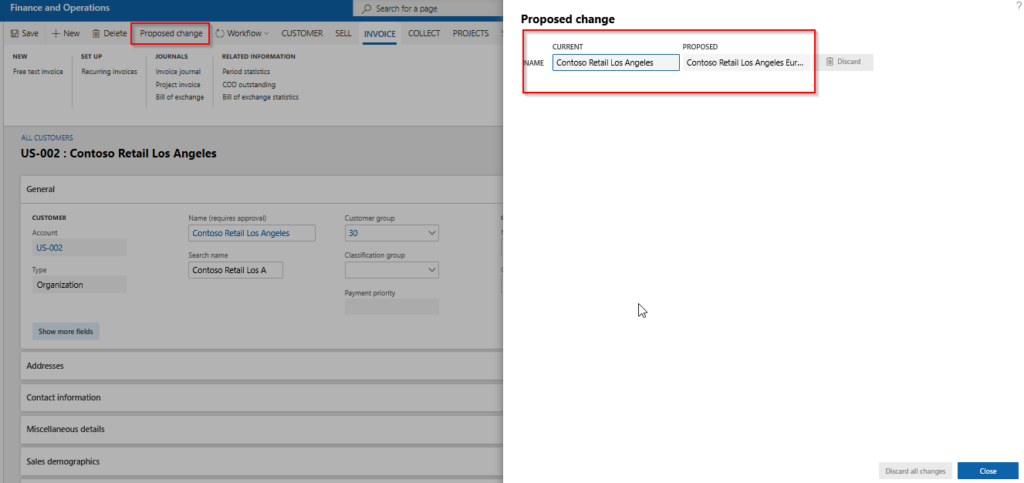
Once the workflow approval request completes, system then updates the customer name in the customer master with the proposed field value.
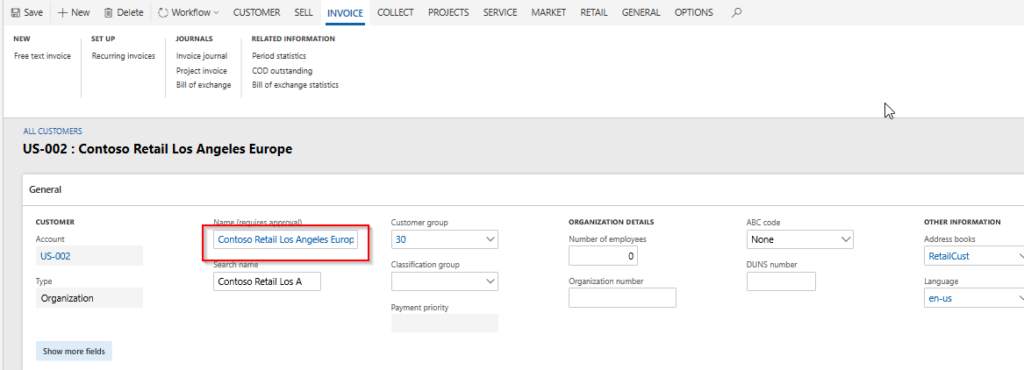
This concludes the illustration of Customer change approvals feature.




